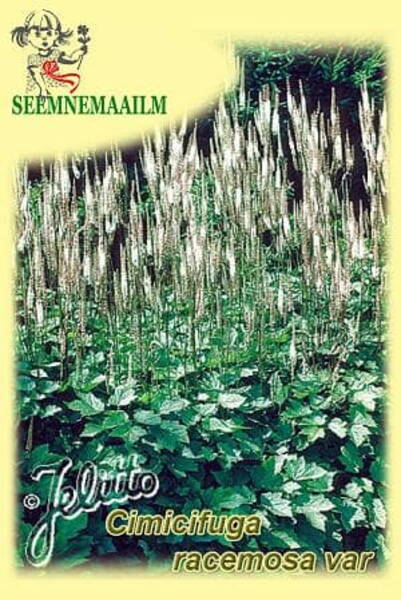Your shopping cart is empty!
Black Bugbane (Black Cohosh)
Cimicifuga racemosa var. cordifolia
2.79€
Ex Tax: 2.25€
Ex Tax: 2.25€
Black Snakeroot (Black Cohosh) - Cimicifuga racemosa var. cordifolia.
Flowers or seedcapsules for cutting.
Flowering period: VIII-X.
Winter hardiness zones: Z3-7.
Cream-white.
Native to eastern North America.
The plant is perennial. Stems erect, branched, leafy and up to 200 cm tall. The bush grows up to 60 cm wide. The rhizome is highly developed, the roots are large, fibrous in large numbers. The leaves are large, petiolate, arranged in the next order, twice or thrice trifoliate and serrated along the edge. The flowers are white, small, with a honey smell, collected in long, racemose terminal inflorescences up to 80 cm long. Cimicifuga blooms from July to September, the flowers in the inflorescence open gradually, from bottom to top. Fruiting. In culture since 1732.
Location: sunny, protected from the wind, tolerate partial shade.
Soil: prefers well-drained, fertile, moderately moist soil
Care: although thin flower stalks are distinguished by an enviable strength, they are not always able to resist in strong wind or in a downpour, therefore, especially for tall specimens, it is better to provide support. In order for the bushes to shine with freshness all season long, the soil under them is mulched to retain moisture, and in dry weatherfor it is watered abundantly. Weeds under the canopy of powerful black cohosh leaves survive poorly and do not cause much trouble. Diseases and pests do not particularly annoy the plant. Withered inflorescences are cut off if there is no desire to admire first greenish-white, and later brown pods, which in warmer countries are often left for the whole winter. During the autumn cleaning of the garden, the stems are cut near the ground. Cimicifuga does not tolerate transplantation well, but if you do not touch it, then it will thank you for its powerful beauty, which grows from year to year.
Reproduction: dividing the bush every 5-6 years, green cuttings and seeds. Cimicifuga can be divided after 5-6 years.
Plants obtained from seeds bloom in the second or fourth year.
They grow in one place for 15-20 years.
Flowers or seedcapsules for cutting.
Flowering period: VIII-X.
Winter hardiness zones: Z3-7.
Cream-white.
Native to eastern North America.
The plant is perennial. Stems erect, branched, leafy and up to 200 cm tall. The bush grows up to 60 cm wide. The rhizome is highly developed, the roots are large, fibrous in large numbers. The leaves are large, petiolate, arranged in the next order, twice or thrice trifoliate and serrated along the edge. The flowers are white, small, with a honey smell, collected in long, racemose terminal inflorescences up to 80 cm long. Cimicifuga blooms from July to September, the flowers in the inflorescence open gradually, from bottom to top. Fruiting. In culture since 1732.
Location: sunny, protected from the wind, tolerate partial shade.
Soil: prefers well-drained, fertile, moderately moist soil
Care: although thin flower stalks are distinguished by an enviable strength, they are not always able to resist in strong wind or in a downpour, therefore, especially for tall specimens, it is better to provide support. In order for the bushes to shine with freshness all season long, the soil under them is mulched to retain moisture, and in dry weatherfor it is watered abundantly. Weeds under the canopy of powerful black cohosh leaves survive poorly and do not cause much trouble. Diseases and pests do not particularly annoy the plant. Withered inflorescences are cut off if there is no desire to admire first greenish-white, and later brown pods, which in warmer countries are often left for the whole winter. During the autumn cleaning of the garden, the stems are cut near the ground. Cimicifuga does not tolerate transplantation well, but if you do not touch it, then it will thank you for its powerful beauty, which grows from year to year.
Reproduction: dividing the bush every 5-6 years, green cuttings and seeds. Cimicifuga can be divided after 5-6 years.
Plants obtained from seeds bloom in the second or fourth year.
They grow in one place for 15-20 years.
Eng.: Black Bugbane, Black Cohosh, Black Snakeroot. Bot. syn.: Actaea racemosa L., Cimicifuga serpentaria Pursh; Botrophis actaeoides Fisch. et C. A. Mey.












